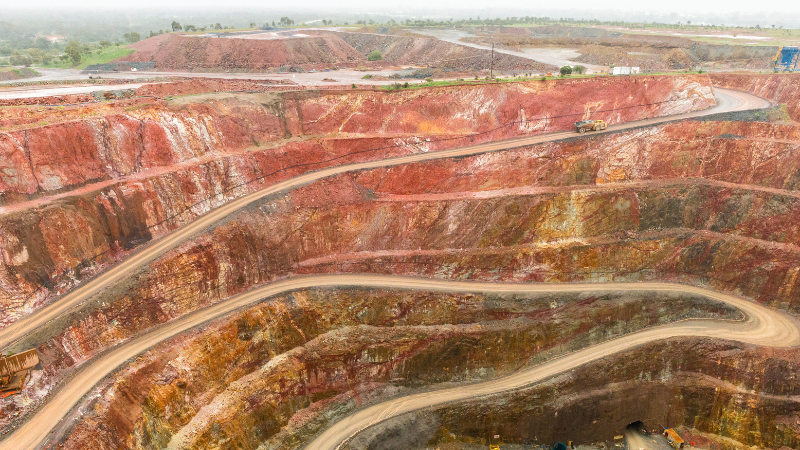This article was originally published by the Macdonald-Laurier Institute in Canada. It was republished for an international audience in the The Diplomat.
By Joseph Bouchard, March 26, 2024
After more than a decade of aggressive expansion, China now stands tall as the world’s largest mining producer and financier by some margin. It is the leading miner of aluminum, coal, gold, magnesium, tin, zinc, manganese, tungsten, phosphate, nitrogen, potash, and other critical minerals.
Canada, which used to be a leading force in the mining sector despite its small demographic size and investment pool, is now at the bottom end of the global top 10 producers. Still, China is looking to capitalize on the extent of Canada’s mining network nationally and around the world in order to advance its interests. With Canadian mining companies desperate for cash and the Canadian government showing little interest in investing money of its own in the sector (especially in comparison to China), Chinese firms are taking advantage of their leadership position to invest in Canadian mining operations. Even taking into account the government’s recent Investment Canada Act (ICA) and the Critical Minerals Strategy, China has made Canadian efforts look paltry by comparison.
As part of Canada’s aims to reduce Chinese economic influence in Canada, the Canadian government implemented the ICA in late 2023. The ICA gives the government the ability to review and turn down any foreign investments if they are deemed not beneficial to the Canadian economy and society, while promoting “positive foreign investment.” The national security component of the ICA is said to be used to reject Chinese mining investment in Canada.
The ICA is complemented by the recent Critical Minerals Strategy, which aims to decouple Canada’s mining supply chains from China and other adversary nations, while stimulating the Canadian and allied critical mineral sector. In line with these strategies, Canada ordered three Chinese firms to divest from their Canadian mining investments in November 2022, two of which were based in Hong Kong.
However, early this year, Zijin Mining bought a 15 percent stake in Canadian-owned Solaris, presenting a test to the ICA and Critical Minerals Strategy. Most recently, Chengdu-based Shenghe Resources acquired a stake in Australian company Vital Metals, which owns a rare earths mine in the Northwest Territories, a deal that included buying the mine’s entire rare earths stockpile. China’s Simonine Resource Group also purchased one of Canada’s only two lithium mines in Manitoba in 2019, a move that was left unchallenged.
Jiangxi Copper, one of the largest Chinese state-owned mining companies, also took over a majority stake in First Quantum Minerals, a Canadian company, in November 2023, which up until recently operated a copper mine in Colón, Panama worth over 5 percent of Panama’s total gross domestic product, as well as other large mines in Latin America, Africa, and elsewhere.
The state-run China Investment Corporation is also the largest shareholder in Teck Resources and Ivanhoe Mines, both based in Vancouver.
The ICA has yet to make a dent in these investments.
These strategies will not truly work until there is a serious effort to bring domestic and allied capital into the Canadian mining sector, which desperately needs it. The Canadian government and mining companies are stuck in a difficult position: while they may not agree with China’s ideological or geopolitical posture, China is the global leader in the mining sector, and has the energy and money to sustain the domestic industry. Minister of Natural Resources Jonathan Wilkinson even went so far as to say that “of course Canada will continue to have trade with China, [and] some of that may involve trade in critical minerals.”
China has developed a prominent role as a financer in the country, which has spiked since Xi Jinping’s rise to power in 2012. In the 12 years since, China has been the most aggressive financier of mining operations in the world, having invested $1.3 trillion in over 20,000 projects in 165 middle- and low-income countries. The first instance of Chinese mining investment in Canada came in February 2012, when the firm Cameco, received unspecified but “considerable” Chinese investment before seeing record earnings in the first quarter of the same year. Later in September, Canada signed a Foreign Investment Promotion and Protection Agreement with China, which could boost Chinese mining investment in Canada.
Now, China has links to more than two dozen Canadian mining companies with stakes in critical minerals. This has not been without its controversies. In 2016, a report from the CBC outlined that Canada was making “too-rosy investment pitches” to China in the mining sector, with Canada overhyping its mining sector and economic incentives to entice investment from China.
With a growing need for capital and faced with few alternatives, however, Canadian mining companies are continuing to accept Chinese financing and investment. While the global demand for critical minerals increasing, many Canadian mining companies – and the Canadian government along with it – have been unable to meet that demand. Companies, especially smaller and medium-sized companies, are barely profitable and face difficulties attracting investment. Mining, in an increasingly unpredictable geopolitical environment and one where anti-mining protests are so common and disruptive, is a risky and costly business.
China, however, with its nearly unlimited cash and ambitious elite class, is happy to fill the gap. In 2023, China’s metals and mining investment reached a record $19.4 billion, a 158 percent increase from 2022, with China’s Rare Earth Elements mining sector responsible for 60 percent of all production.
Generally, China accounted for about 28 percent of all mining output in 2020, with that share only likely to increase. China is the world’s largest producer of electric vehicles, batteries, solar panels, and wind turbines, and its mining power is helping sustain this production.
Mining, especially in critical minerals, is immensely important to Canada’s economic, energy, geopolitical, and security interests, but Canada has few alternatives. Despite the passing of the Inflation Reduction Act in the U.S., and critical mineral funding opportunities from the Department of Energy and Department of Defense, investment is not flowing at the levels needed to move the dial. The Biden administration has implemented programs such as the China and Transformational Export Program through the U.S. Export-Import Bank to stem the bleeding, but China retains its comparative advantage in this sector and a lack of private investment from the West is conspiring against a meaningful disruption to its pole position.
There are still a few policy alternatives Canada and its allies haven’t tried. Promoting domestic investment through public economic measures could allow for greater capital flow into Canadian mining. Options could include the federal government encouraging stock buy-backs, or providing cheap loans for mining investors, like the Inflation Reduction Act does for the U.S. It could establish strategic reserves of critical minerals similar to the petroleum reserves organized through the International Energy Agency.
It would also be helpful to make the regulatory process around mining, which on average takes years if not decades to complete, swifter, cheaper, and easier to navigate. Doing so would make investments less risky as well, given the shorter time horizons they would require before the start of operations, which sometimes can mean fluctuating commodity prices (and with that, fluctuating profit).
Encouraging other, more friendly foreign actors, like the U.S. or Australia, to invest in Canadian mining could also be another considerable option. If Canada could negotiate some kind of mining agreement or investment deal beyond existing free trade agreements, it could boost bilateral mining cooperation. Lowering the regulatory bar of entry for foreign investment from allied nations like the U.S. and Australia would be a significant help. Canadian mining executives themselves are asking for it.
Both the U.S. and Australia have already expressed concerns over China’s dominance in the mining and critical minerals sectors, and pushed back against Chinese acquisition of Western mining operations. Yet, the lack of foreign capital from outside China has made the shift difficult, and other countries will need to step up if they want a larger role in the future of the mining sector – especially with global demand for critical minerals expected to increase. This kind of public backing and multilateral cooperation could just be the key to increasing energy independence.
Joseph Bouchard is a freelance journalist covering geopolitics in the Americas, with reporting experience in Bolivia, Colombia, and Brazil. His articles have appeared in The Diplomat, Mongabay, Le Devoir, Responsible Statecraft, The National Interest, and Brazilian Report. He is a contributor with Young Voices.








